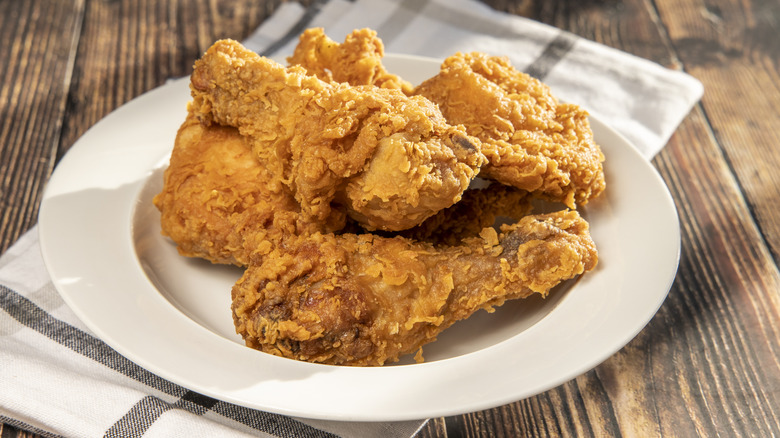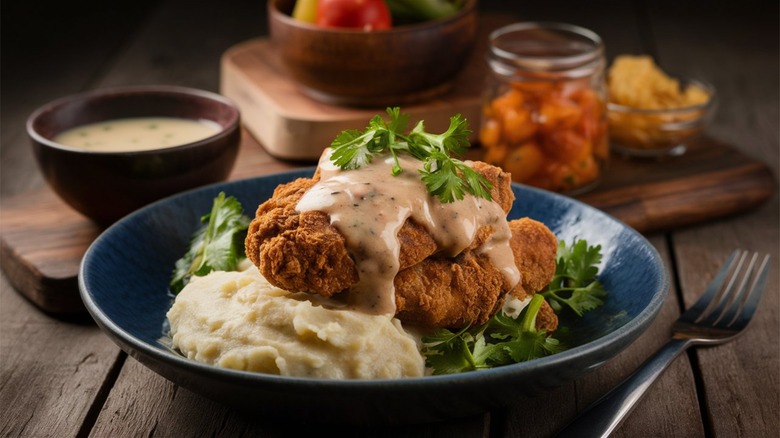The Little-Known Scottish Origins Of Fried Chicken
We may receive a commission on purchases made from links.
From Sunday lunches after church to National Fried Chicken Day, plenty of Americans enjoy fried chicken — and this fascination only continues to grow. According to the National Chicken Council, in 1960, the average American ate 28 pounds of chicken. In 2023, that number exploded to 101 pounds a year.
The first widely accepted recipe for American fried chicken comes from the 1824 cookbook "The Virginia Housewife" written by Mary Randolph, who was born at her family plantation called Ampthill in Virginia. She went on to live in Richmond, Virginia, and then the District of Columbia.
It may come as a shock that the origins of fried chicken might be found in Scotland and not the American South. In the first edition of "The Encyclopedia of American Food and Drink," published in 1983, author John F. Mariani claimed that the Scottish people brought fried chicken when they immigrated to the American South in the 18th century. And this immigration potentially brought a proto-recipe for fried chicken, pre-dating the first publication of "The Virginia Housewife."
The early days of fried chicken
The first piece of evidence that fried chicken originated in Scotland is a recipe from the 1747 British cookbook "The Art of Cookery Made Plain and Easy," by Hannah Glasse. For those of you doing the math, that's nearly 80 years before the first official fried chicken recipe in America. Glasse wasn't Scottish, but the cookbook incorporated traditional recipes from all of Britain. While the recipe isn't titled "fried chicken," when you look at the instructions, it's easy to draw a connection to traditional American renditions — namely, making a thick batter of flour, eggs, and butter, and frying the chicken in lard.
Finally, we have an essay penned by the 18th-century history professor at the University of Edinburgh, Stana Nenadic. In this essay, Nenadic references a diary entry dated to 1773, in which Scottish writer James Boswell recalls having fried chicken for dinner while visiting the Isle of Sky. This may seem like substantial evidence, but assigning the origins of Southern fried chicken to Scotland and Scottish immigrants is still just a fascinating theory rather than cold, hard fact. It is just as likely that enslaved people from Western Africa brought over familiar cooking techniques that eventually translated into the fried chicken we know today — or that the two cultures fused to create the fried chicken we know today.
The evolution of fried chicken
Like with many foods, each culture that interacts with it adds its own cooking techniques and flavor. The Scottish differed from the traditional English cooking method of boiling their chickens. Instead, the Scots covered their chickens in a thick batter and fried them in pork lard. One key thing to note is the Scottish people didn't season the batter before frying.
This would change once they immigrated to the Southern United States. Enslaved people working on the plantations of enslavers were allowed to raise chickens. With an abundance of said fowl, the enslaved population began to fry and eat chickens. Using the techniques brought with them from West Africa, they seasoned the chickens with paprika and other familiar spices. In time, fried chicken became a part of Southern culture, likely a blend of different cuisines.
Of course, fried chicken is enjoyed across the world in different international styles that are worth traveling for, with exciting and delicious new ingredients like yogurt, potato starch, rice flour, and prawn paste. In America, fried chicken recipes can still find their roots in the South, using ingredients like flour, paprika, and garlic. However, new recipes and ways of cooking are always being tried. For example, to get extra crispy fried chicken, grab the vodka. In addition, buttermilk fried chicken with cauliflower puree takes a traditional take and elevates it to new heights.



